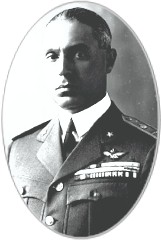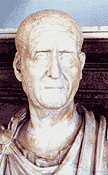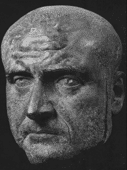|

AUGUST MEETING
AUGUSTUS, VIRGIL AND THE AENEID
|
Our August speaker will be dynamic and popular member
Anna Amelung (Tombstone Inscriptions of Roman Women) who
will introduce the Aeneid of Virgil, one of the most important
works of Latin literature. Composed in the first century B.C., the
poem celebrates the legendary origins of the Roman race and describes the
trials and tribulations of Aeneas, a Trojan hero who journeyed to Italy
from the shores of Asia Minor and became the ancestor of the Romans.
This national epic poem depicts Aeneas as a new social hero, reflects the
values of the rising Empire established by Augustus, and is also a very
clever piece of political propaganda, since it glorifies the Roman empire.
The Aeneid enjoyed an extraordinary success throughout the centuries,
as Virgil was seen not only as a literary genius but also as a prophet
who foretold the coming of Christ. Dante himself took Virgil as his
guide and teacher in the Divina Commedia thus contributing to the
undying success of the poem.
The presentation will serve as an introduction to a three
session mini-seminar on the Aeneid that Dr. Amelung will lead this coming
autumn as a joint endeavor with the Classical Club of St. Louis,
of which Anna is the President. Dr. Amelung has received the Laurea
in Foreign Languages from the Università di Bologna and a Ph.D.
in French Literature from Washington University. After teaching in
France and Italy, she now teaches Latin and French at University City High
School, sharing her knowledge and love for the ancient world with the youth
of modern America.
|
|
Next Meeting Wednesday, August 21, 2002
Cocktails 6:30 PM - Dinner 7:00 PM
Da Baldo's Restaurant
RSVP Gene Mariani
(314) 352-5484
or by email
|

RECAP OF JULY MEETING
DE PINEDO AND THE WINGS OF ITALY
|
 Our July speaker was Franco Giannotti, who is so well known to the
Italian community that he needs no introduction. What might not be
known is that he is an Italian Air Force veteran with great interest in
and knowledge of aviation. He participated in the preparation of
the recent De Pinedo 75th anniversary celebration in Chicago and gave a
presentation on De Pinedo at the June meeting of Italiano per piacere,
therefore it was a real pleasure to hear his expert narration of the adventures
of the Italian aviator Francesco De Pinedo.
Our July speaker was Franco Giannotti, who is so well known to the
Italian community that he needs no introduction. What might not be
known is that he is an Italian Air Force veteran with great interest in
and knowledge of aviation. He participated in the preparation of
the recent De Pinedo 75th anniversary celebration in Chicago and gave a
presentation on De Pinedo at the June meeting of Italiano per piacere,
therefore it was a real pleasure to hear his expert narration of the adventures
of the Italian aviator Francesco De Pinedo.
Born in Naples in 1890 from a patrician family, De Pinedo
was a cultured gentleman who had little in common with the roguish, daredevil
aviator typical of his time. Reserved and formal, he did not like
to communicate, not even in writing, an unsettling trait for Mussolini,
who was forced to keep up with his aviator’s progress through the newspapers.
To satisfy his wanderlust, at the age of 18 De Pinedo joined
the Italian Royal Navy, but after six years he realized that aviation,
then in its infancy, was more to his liking. In just 45 days he received
his flying license and used his newly acquired skill during WW1, earning
decorations, promotions, and the reputation of being a very promising pilot.
He was transferred to the newly formed Italian Royal Air Force with the
rank of Lieutenant Colonel and with executive functions at the Supreme
Command in Rome.
At the age of 33 De Pinedo has arrived, but the sedentary
life in the Air Force Ministry is not what De Pinedo wants, so he manages
to convince his superiors that Italy must prove that its pilots and airplanes
are the best in the world and that the best way to accomplish this is to
engage in far reaching air missions.
For his flights De Pinedo uses seaplanes built by Savoia-Marchetti
of Sesto Calende, near Lago Maggiore. In 1925 for his first mission
he flies the Gennariello, a single-engine S16 seaplane, on
a 34-mile trip to Tokyo by way of Australia.
In his second mission he flies to South America, North
America, and return, covering 36,000 miles and four continents. He
chooses the new S55 seaplane, a catamaran with dual push-pull in-line engines,
named the Santa Maria. With a crew of three, in February
1927 he departs from Sesto Calende and reaches Boloma, from where the Atlantic
crossing is to begin. After several delays, on February 22 he is
able to take off from Capo Verse. The crossing is marred by bad weather,
but finally they reach the coast of Brazil after 15 hours of flight.
From here they fly to Argentina and Cuba, everywhere greeted with enthusiasm
by the locals. On March 29 they reach New Orleans, establishing
a historical milestone, since this date marks the first time that a foreign
pilot has landed a foreign aircraft in the USA. It is less than two
months before the famous Charles Lindbergh crossing.
From here they fly to San Antonio, Texas, and Arizona,
where a regrettable accident occurs: here the Santa Maria
goes up in flames when a careless worker throws a cigarette butt into the
water, igniting the thin layer of gasoline that was floating on it.
The U.S. apologizes to the Italian Government and offers a replacement
plane, but Mussolini refuses and instructs the Savoia-Marchetti to send
another plane, to be transported to New York by ship.
After the Santa Maria II arrives, De Pinedo
draws a new route and decides to skip all stops west of the Mississippi,
including St. Louis, disappointing hundreds of St. Louisans who must be
satisfied with a glimpse of the flying boat. The bad weather causes
many delays but De Pinedo finally arrives in Montreal on May 17.
The weather continues to deteriorate so it takes them three days to reach
Newfoundland, from where the return crossing is to start. After several
take-off attempts, the news arrives that Charles Lindbergh has successfully
landed in Paris.
The Santa Maria II finally takes off but soon it
encounters strong head winds and after a few hours of flight it becomes
obvious that fuel consumption is higher than expected. Luckily they
spot a fishing boat, the Portuguese Infante de Sangres and De Pinedo
convinces the captain to take him in tow. They are some 200 miles
short of the Azores.
While the entire world is celebrating Charles Lindbergh,
the Italians are beginning to mourn the loss of De Pinedo. Neither
the aircraft nor the fishing boat are equipped with radio and all that
the Italians know is that De Pinedo left Newfoundland the day before and
must therefore be lost at sea.
But the following day a British ship radios in that it
has sighted a fishing vessel towing a white plane. Jubilant, the
Italians order the Italian cargo ship Superga to meet the Portuguese
fishing boat and take over the tow of the aircraft to the Azores, where
the plane is lifted on land to repair the wing damage suffered in the tow.
After a few days De Pinedo and crew take off again and return west to the
point where they met the fishing boat before turning east towards home.
The extra step was taken to make sure that the complete route was actually
flown.
There is no need to rush it anymore. Now the aviators
take their time to stop in Portugal and Spain before finally touching down
in Orbetello (Ostia), very near the location where today is the International
Airport of Fiumicino.
To welcome the aviators are members of the royal family,
Mussolini, Italo Balbo and thousands of cheering Italians. De Pinedo
is acclaimed a national hero and the entire country is in ecstasy.
The British government presents De Pinedo with its Air
Force Cross “for distinguished service to aviation". The British
probably wanted to remind everyone that Lucky Lindy wasn't the only man
who flew an airplane in 1927! Today, however, Marchese Generale
Francesco De Pinedo is just about forgotten by historians, educators and
mass media.
Perhaps the best epitaph for his endeavor is a quote from
Professor Gregory Alegi of Rome, who said: “It’s really too bad that
history has only space for one hero”.
For more information on the extraordinary accomplishments
of Francesco De Pinedo, visit our website www.italystl.com.
|
|

L’ANGOLO DEL PRESIDENTE
By Gene Mariani |
 |
|
WELCOME NEW MEMBERS
|
We are pleased to announce that Mr. Jerry Galleano
was elected a member of the Italian Club at the July 17 meeting.
Welcome to the Club, Jerry. It is good to have you with us.
|
THE ITALIAN
CLUB OF ST. LOUIS
CELEBRATES ITS 80th ANNIVERSARY
|
The Club will celebrate its 80th year with a special party
on Sunday, December 8, 2002. Because of the number of people that
we expect will be attending this event, the celebration will be held at
the Westborough Country Club. It will be an evening you will not
want to miss – so mark your calendars. More details will be announced
soon.
|
ITALIAN CONVERSATIONAL
TABLE
|
Depending on the level of interest, the Club will continue
its Italian Conversational Table program this autumn. Anyone
interested in participating is asked to contact Gene Mariani at
352-5484 or by email at emariani@aol.com.
The Table meets weekly for an hour and is intended for people wishing to
practice Italian conversation in a small group setting with the help of
an Italian-speaking facilitator.
|
|

|
ANNOUNCEMENTS
DARK EYES
A HIT AT THE SAINT LOUIS ART MUSEUM
|
The Italian Club/Saint Louis Art Museum sponsored film,
Dark Eyes, screened at the museum auditorium on July 12, had an
attendance of 310 people. Many thanks to the IC board members who
donated their time to help with the many tasks involved in the project
and special thanks to Dorotea Rossomanno- Phillips for her excellent
introduction of the work. Also molte grazie to the Art Museum
for its wonderful support, cooperation, and encouragement.
The next event in the Italian Club/ Saint Louis Art
Museum Italian film series will be on Friday, October 18. Based
on the popularity of the series, it will be expanded to have two films
presented on the same day: Divorce, Italian-Style at 4:00
PM and the Mastroianni retrospective, Io Ricordo, Io Ricordo at
7:00 PM
|
|

SEMINAR ON VIRGIL’S AENEID
|
We are pleased to announce that the Italian Club will
continue its seminar series on literature this autumn with a three-session
discussion of the Aeneid, the greatest poem of classical Roman literature.
It will be a joint program with the Classical Club of St. Louis.
The seminar leader will be Dr. Anna Amelung, President of the Classical
Club, who will introduce the topic at the August 21 club meeting (see page
1 for more information).
Seminar discussion topics will be:
-
September 12: Aeneas, the chosen one (Excerpts from Books I, II
and III)
-
October 10: The tragedy of Dido (Excerpts from Books IV and VI)
-
November 14: War in Italy. (Excerpts from Books VII – XII)
The sessions will be held at the Southwest Bank on Thursday
evenings from 7:00 to 8:00 p.m. Knowledge of Latin is not required
as readings/discussion will be in English. If you attended our seminar
on Dante’s Divina Commedia, you won’t want to miss this one. There
is no charge for attending the sessions; however space is very limited,
so make reservations as soon as possible by calling Gene Mariani at 352-5484
or by email.
|
|

LA TOSCA AT UNION AVENUE OPERA
THEATRE
|
UAOT continues its season with Puccini’s masterpiece Tosca
on August 16, 17, 23, and 24. Scott Shoonover, Artistic Director and founder
of Union Avenue Opera Theatre, will conduct.
All performances are sung in Italian with projected
translations. On August 16th Dr. Glen Bauer, Director of Music
History and Literature at Webster University, will give a pre-concert program
at 7 PM. Dr. Bauer recently visited Italy and all the sites where
the events of Tosca took place.
All performances begin at 8 PM at Union Avenue Christian
Church, 733 North Union Blvd., located one block north of Delmar.
Center front tickets are $25. General Admission tickets are $20 and
tickets for students and seniors are $18. Doors open at 7:15 PM.
For more information call 314-361-2881 or e-mail uaot@juno.com.
Ed Note: For more details and cast see "New
In St. Louis"
|
|




The Italian Club of St. Louis
|
|
|
|


| I capolavori della poesia italiana
Umberto Poli (Trieste 1883 – Gorizia 1957) prese
il cognome di Saba (“pane” in ebraico) in omaggio alle origini della madre,
che fu abbandonata dal marito alla nascita del poeta. La sua infanzia
non fu felice e probabilemente causò le molte nevrosi che lo afflissero
nell’età adulta. Condusse una vita appartata dedicandosi alla
stesura della raccolta di poesie intitolata “Il canzoniere”.
Preghiera alla madre
di Umberto Saba
Madre che ho fatto
soffrire
(cantava un merlo alla finestra, il giorno
abbassava, sì acuta era la pena
che morte a entrambi io m’invocavo)
madre
ieri in tomba obliata, oggi rinata
presenza,
che dal fondo dilaga quasi vena
d’acqua, cui dura forza reprimeva,
e una mano le toglie abile o incauta
l’impedimento;
presaga gioia io sento
il tuo ritorno, madre mia che ho fatto,
come un buon figlio amoroso, soffrire.
Pacificata in me ripeti antichi
moniti vani. E il tuo soggiorno un verde
giardino io penso, ove con te riprendere
può conversare l’anima fanciulla,
inebbriarsi del tuo mesto viso,
sì che l’ali vi perda come al lume
una farfalla. È un sogno,
un mesto sogno; ed io lo so. Ma giungere
vorrei dove sei giunta, entrare dove
tu sei entrata
- ho tanta
gioia e tanta stanchezza! -
farmi, o madre,
come una maccha dalla terra nata,
che in sé la terra riassorbe ed annulla.
|
|

(Continua dal numero precedente)
 Gaio
Messio Decio (190-251) (Imperatore 249-251). Dopo la vittoria
su Filippo Arabo a Verona, il Senato si affrettò a confermare l’elezione
di Decio a imperatore anche se lui persisteva nel dichiarare di essere
stato nominato contro la propria volontà. Gaio
Messio Decio (190-251) (Imperatore 249-251). Dopo la vittoria
su Filippo Arabo a Verona, il Senato si affrettò a confermare l’elezione
di Decio a imperatore anche se lui persisteva nel dichiarare di essere
stato nominato contro la propria volontà.
Sembra che Decio fosse un uomo di grande abilità, sinceramente
interessato a rendersi degno della posizione per cui era stato prescelto.
Per prima cosa Decio decise di ristabilire la disciplina e la severità
delle antiche virtù romane e il culto degli dei e a questo scopo
diede all’illustre senatore Valeriano la carica di Censore, carica da tempo
dimenticata e andata in disuso; questo causò una breve ma intensa
persecuzione dei cristiani, che erano rimasti indisturbati dai tempi di
Marc’Aurelio, perché erano visti da Decio come una minaccia contro
il governo romano.
Ma nel 250 Decio dovette dedicare la sua attenzione a pericoli
più pressanti. Infatti le orde dei Goti avevano attraversato
il Danubio, saccheggiato la Mesia e assediato le fortezze di Nova e Marcianopoli.
Il sopraggiungere di Decio spinse i Goti ad abbandonare l’assedio ed a
spingersi fino a Filippopoli, che fu assediata e sconfitta. Decio
riorganizzò il suo esercito e bloccò il passaggio dei Goti
sui Balcani, ma dopo alcuni scontri il suo esercito fu sconfitto e sia
Decio che il figlio Erennio Etrusco furono uccisi in battaglia.
 Treboniano
Gallo (206 –253) (Imperatore 251-253). Dopo la morte
di Decio, l'esercito della Mesia proclamò imperatore Treboniano
Gallo. Giunto a Roma , Gallo deificò Decio ed Erennio e diede
il titolo di Cesare al secondo figlio del morto imperatore, Caio
Valente Ostinano. Poco tempo dopo, quando Ostiliano morì
di peste, Gallo associò nell'impero il proprio figlio Volusiano,
che aveva sposato una figlia di Decio. Seguendo l’esempio di Decio,
anche Gallo perseguitò i Cristiani ma con i Goti concluse una pace
simile a quella che Domiziano aveva concluso con i Daci, permettendo loro
di lasciare il territorio dell' impero con il bottino di guerra e i prigionieri
e promettendo loro larghe somme di denaro. Treboniano
Gallo (206 –253) (Imperatore 251-253). Dopo la morte
di Decio, l'esercito della Mesia proclamò imperatore Treboniano
Gallo. Giunto a Roma , Gallo deificò Decio ed Erennio e diede
il titolo di Cesare al secondo figlio del morto imperatore, Caio
Valente Ostinano. Poco tempo dopo, quando Ostiliano morì
di peste, Gallo associò nell'impero il proprio figlio Volusiano,
che aveva sposato una figlia di Decio. Seguendo l’esempio di Decio,
anche Gallo perseguitò i Cristiani ma con i Goti concluse una pace
simile a quella che Domiziano aveva concluso con i Daci, permettendo loro
di lasciare il territorio dell' impero con il bottino di guerra e i prigionieri
e promettendo loro larghe somme di denaro.
Le legioni si ribellarono contro queste condizioni che
consideravano disonorevoli e si unirono al generale mauritano Emilio Emiliano,
il quale aveva promesso che li avrebbe ricompensati dando loro il denaro
che Gallo aveva promesso ai Goti.
Dopo aver sconfitto i Galli, i pretoriani uccisero Gallo e il figlio
Volusiano e dichiararono Emiliano imperatore.
(continua al prossimo numero)
Ed Note: The entire series, to date, can be viewed on this
Portal at Storia d'Italia |

|
|